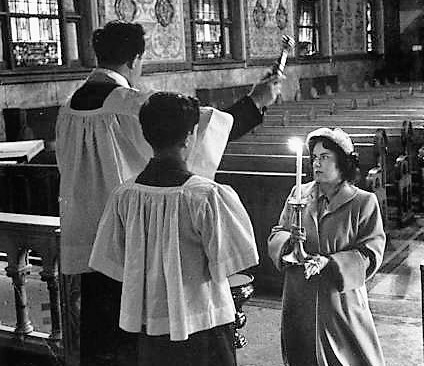 On Saturday we celebrated the Feast of the Presentation. I thought it might be appropriate to describe a related liturgy of the Church that has been largely lost: The Churching of Women. To some extent it is subsumed in the modern Rite of Baptism with the blessing of the mother, but it is not what it used to be. We may still celebrate this for women who ask, and I often do so, especially in extraordinary form baptisms.
On Saturday we celebrated the Feast of the Presentation. I thought it might be appropriate to describe a related liturgy of the Church that has been largely lost: The Churching of Women. To some extent it is subsumed in the modern Rite of Baptism with the blessing of the mother, but it is not what it used to be. We may still celebrate this for women who ask, and I often do so, especially in extraordinary form baptisms.
The Churching of Women is rooted in the Feast of the Presentation. Biblically this feast commemorates the Jewish practice of a woman presenting herself at the temple forty days after the birth of a male child in order to be “purified” and blessed by the priest. As an observant Jew, Mary fulfilled this obligation and it is recorded in Luke’s Gospel:
When the time of their purification according to the Law of Moses had been completed, Joseph and Mary took him to Jerusalem to present him to the Lord (as it is written in the Law of the Lord, “Every firstborn male is to be consecrated to the Lord” and to offer a sacrifice in keeping with what is said in the Law of the Lord: “a pair of doves or two young pigeons” (Luke 2:22-24).
The Jewish practice of “purifying” a woman after childbirth was set forth in the Book of Leviticus:
The LORD said to Moses, “Say to the Israelites: A woman who becomes pregnant and gives birth to a son will be ceremonially unclean for seven days, just as she is unclean during her monthly period. On the eighth day the boy is to be circumcised. Then the woman must wait thirty-three days to be purified from her bleeding. She must not touch anything sacred or go to the sanctuary until the days of her purification are over. If she gives birth to a daughter, for two weeks the woman will be unclean, as during her period. Then she must wait sixty-six days to be purified from her bleeding. When the days of her purification for a son or daughter are over, she is to bring to the priest at the entrance to the Tent of Meeting a year-old lamb for a burnt offering and a young pigeon or a dove for a sin offering. He shall offer them before the LORD to make atonement for her, and then she will be ceremonially clean from her flow of blood. These are the regulations for the woman who gives birth to a boy or a girl. If she cannot afford a lamb, she is to bring two doves or two young pigeons, one for a burnt offering and the other for a sin offering. In this way the priest will make atonement for her, and she will be clean” (Leviticus 12:1-8).
As you can see, there is a fairly negative concept at work here: A woman becomes ritually “unclean” by giving birth due to the flow of blood and other fluids. (Note that ritual impurity is not the same as moral impurity.) And a woman who gave birth to a daughter was considered ritually unclean for even longer! It is well that the Church’s power to bind and loose has freed us from this thinking. Keep in mind that this was ceremonial law, not moral law, so the Church is not setting aside immutable moral law in abrogating this notion of ritual impurity.
Nevertheless, the custom and instinct of blessing women after childbirth was retained in the Church, albeit with an altered understanding from Jewish teaching. The rite came down through the centuries and was largely intact until very recent times. (The official Latin title of the Rite was Benedictio Mulieris Post Partum, the blessing of women after giving birth. The rite was largely discontinued in the 1960s in the wake of the Second Vatican Council. The Book of Blessings published in 1984 does contain a “Blessing of a Woman after Childbirth,” but it is seldom used and is significantly altered from the old rite that was use until the mid-1960s. There is also a blessing of the mother at the Rite of Infant Baptism.
There are many reasons for the discontinuance. I remember my mother and other women of her generation saying they had been taught the Jewish history of this rite and rejected it for that reason, but the Catholic Church was clear to distinguish its practice from the Jewish roots. As early as the 6th century, Pope Gregory protested the notion that childbirth caused defilement. Further, the prayers of the old Churching of Women Rite did not mention a need for purification, speaking only of blessing and thanksgiving. So, those who taught women of my mother’s generation against this practice were probably engaged more in polemics than anything else. Another reason for the discontinuance was probably just because so many things were dropped after the Council.
I would like to recommend this beautiful ritual to your attention. In an extended sense it fulfills what Mary did forty days after the birth of Christ. We do not understand it in an Old Testament way, but we rescue and fulfill the tradition with the beauty of Christian faith and the dignity of mothers.
A PDF version of the ritual can be found here: The Churching of Women. Though it has never been required by the Church, it is a beautiful way to welcome back and bless a woman who may have been away for a few weeks after giving birth. She has labored well for her family and this ritual can serve simultaneously as a blessing and thanksgiving extended by the Church to the noble women who are our mothers. The blessing can be given after a baptism or after Mass, collectively to recent mothers or individually. While the current baptismal rite contains a blessing for the mother, this older rite is a more special blessing. Pope Benedict’s Motu Proprio Summorum Pontificum, which permits the use of the older forms of the sacraments, has made these older rituals more available. Here is the concluding prayer of the rite:
Almighty, everlasting God, through the delivery of the blessed Virgin Mary, Thou hast turned into joy the pains of the faithful in childbirth; look mercifully upon this Thy handmaid, coming in gladness to Thy temple to offer up her thanks: and grant that after this life, by the merits and intercession of the same blessed Mary, she may merit to arrive, together with her offspring, at the joys of everlasting happiness. Through Christ our Lord.
Cross-posted at the Catholic Standard: The Churching of Women


“As you can see, there is a fairly negative concept at work here: A woman becomes ritually “unclean” by giving birth due to the flow of blood and other fluids. (Note that ritual impurity is not the same as moral impurity.) And a woman who gave birth to a daughter was considered ritually unclean for even longer! It is well that the Church’s power to bind and loose has freed us from this thinking. Keep in mind that this was ceremonial law, not moral law, so the Church is not setting aside immutable moral law in abrogating this notion of ritual impurity.”
I disagree. I’ve given birth twice and 41 years later lost one of these precious gifts. After childbirth a mother needs to heal. She needs to bond with her baby. In the time of Jesus, this gives the mother downtime when no one expects her to cook, clean, or harvest. As far as a longer period of time if the child was a girl, at that time the girl was expected to stay by her mother’s side until she was married. The bonding time was longer. I mentioned the loss of our son because I needed time to grief. There certain very emotional times in our live when we need time off. I’m also thinking of honeymoons.
The churching of women is a beautiful custom of thanksgiving for coming safely through the sometimes dangerous process of pregnancy and childbirth. I remember seeing my mother do it in conjunction with both my baby brothers’ Baptisms. I was about seven years old at the time, and had already read several stories in which the mothers had died in childbirth (they didn’t shy away from discussing death with small children back then), so I was fully able to understand what was happening and why.
.
I never completely understood why they did away with the custom after Vatican II. Yes, these days actually dying in childbirth is quite rare in developed countries, but it does still happen. And what about the babies who die in the process of being born? The modern use of fetal monitors does prevent most of that, too, but again, it does still happen.
.
Thanksgiving for special events is something we tend to forget. Perhaps if this custom hadn’t been eliminated, we just might remember to be grateful more often.